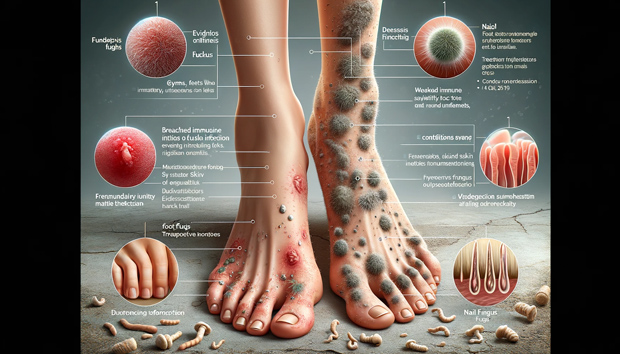The feet are constantly in contact with fungi and bacteria that cause infections. Foot infections should be taken seriously. At best, they cause discomfort, and at worst they can lead to death, but most fungal infections of the feet are somewhere in the middle of the scale. Diagnosis and proper treatment can prevent serious consequences of infection.
Normally, the immune system copes with its task of preventing the appearance of a fungal lesion on the feet, but a person is vulnerable to:
- Foot infections are His immune system is weakened;
- The pathogen (the organism causing the infection) is particularly resistant and contagious;
- The integrity of the skin is violated, which provides easy access of the pathogen to internal structures.
Often mild and can be treated at home. In rare cases, patients require more aggressive treatment. Some infections can even cause serious complications, leading to hospitalization.
It is always easier to prevent an infection than to treat it. Infection of the foot or nail can develop due to staying in the locker room or spa. Mushrooms are particularly resistant and can grow even on intact skin.
The foot, especially the space between the toes, is an ideal environment for fungi, since moist, softened tissues are favorable conditions for them. Fungal infections (mycoses) of the feet can be long-lasting and difficult to treat, but they are rarely life-threatening.
Fungal infection of the foot (mycosis of the foot, epidermophytia of the feet)
An itchy scaly rash between the toes is most often a sign of epidermophytosis of the foot (dermatomycosis of the foot). This infection is caused by several types of fungi, including those associated with ringworm (a condition caused by a fungal infection that causes small, round bumps on the skin).
Fungi love a humid environment — gyms, saunas, and sweaty socks and shoes. Contaminated floors, towels, or clothes contribute to the easy spread of mycoses.
Most cases of yeast infection can be diagnosed only by symptoms. In more serious or recurrent cases, it may be necessary to study the material from skin lesions, which are collected by scraping off the skin with a blunt scalpel. Mild cases can be treated with an over-the-counter antifungal cream or spray. Serious or persistent infections may require oral antifungal treatment. Terbinafine or itraconazole may be prescribed for up to six months.
Nail fungus (onychomycosis)
A common, slow-developing fungal infection under the toenails is called onychomycosis. It is one of the most common nail diseases and, according to various sources, affects up to 10% of people of different ages. Symptoms include:
- White or yellowish nail color;
- Thickened, flaky nails;
- Separation of the nail from the nail bed
Onychomycosis often accompanies mycosis. This is more common in people with a weakened immune system or peripheral vascular diseases (which impair blood flow to the legs).
Tissue cultures from nail clippings can identify the specific fungus that caused the disease. It is known that onychomycosis is difficult to treat. This is partly because topical creams cannot penetrate the nail tissue. With onychomycosis, oral antifungal treatment usually works best, but it may take up to 12 months for the nail to fully regrow, which is healthy.


Leave a Reply